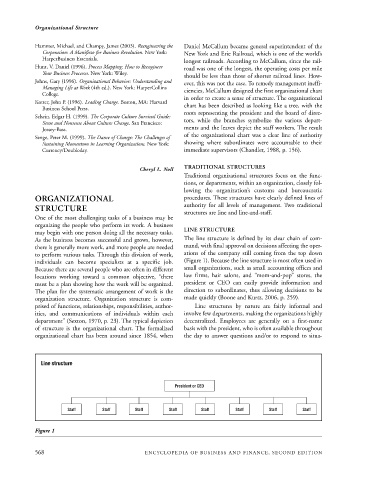Page 591 - Encyclopedia of Business and Finance
P. 591
eobf_O 7/5/06 3:17 PM Page 568
Organizational Structure
Hammer, Michael, and Champy, James (2003). Reengineering the Daniel McCallum became general superintendent of the
Corporation: A Manifesto for Business Revolution. New York: New York and Erie Railroad, which is one of the world’s
HarperBusiness Essentials. longest railroads. According to McCallum, since the rail-
Hunt, V. Daniel (1996). Process Mapping: How to Reengineer road was one of the longest, the operating costs per mile
Your Business Processes. New York: Wiley.
should be less than those of shorter railroad lines. How-
Johns, Gary (1996). Organizational Behavior: Understanding and ever, this was not the case. To remedy management ineffi-
Managing Life at Work (4th ed.). New York: HarperCollins ciencies, McCallum designed the first organizational chart
College.
in order to create a sense of structure. The organizational
Kotter, John P. (1996). Leading Change. Boston, MA: Harvard
Business School Press. chart has been described as looking like a tree, with the
roots representing the president and the board of direc-
Schein, Edgar H. (1999). The Corporate Culture Survival Guide:
Sense and Nonsense About Culture Change. San Francisco: tors, while the branches symbolize the various depart-
Jossey-Bass. ments and the leaves depict the staff workers. The result
of the organizational chart was a clear line of authority
Senge, Peter M. (1999). The Dance of Change: The Challenges of
Sustaining Momentum in Learning Organizations. New York: showing where subordinates were accountable to their
Currency/Doubleday. immediate supervisors (Chandler, 1988, p. 156).
TRADITIONAL STRUCTURES
Cheryl L. Noll
Traditional organizational structures focus on the func-
tions, or departments, within an organization, closely fol-
lowing the organization’s customs and bureaucratic
ORGANIZATIONAL procedures. These structures have clearly defined lines of
STRUCTURE authority for all levels of management. Two traditional
structures are line and line-and-staff.
One of the most challenging tasks of a business may be
organizing the people who perform its work. A business
may begin with one person doing all the necessary tasks. LINE STRUCTURE
As the business becomes successful and grows, however, The line structure is defined by its clear chain of com-
there is generally more work, and more people are needed mand, with final approval on decisions affecting the oper-
to perform various tasks. Through this division of work, ations of the company still coming from the top down
individuals can become specialists at a specific job. (Figure 1). Because the line structure is most often used in
Because there are several people who are often in different small organizations, such as small accounting offices and
locations working toward a common objective, “there law firms, hair salons, and “mom-and-pop” stores, the
must be a plan showing how the work will be organized. president or CEO can easily provide information and
The plan for the systematic arrangement of work is the direction to subordinates, thus allowing decisions to be
organization structure. Organization structure is com- made quickly (Boone and Kurtz, 2006, p. 259).
prised of functions, relationships, responsibilities, author- Line structures by nature are fairly informal and
ities, and communications of individuals within each involve few departments, making the organizations highly
department” (Sexton, 1970, p. 23). The typical depiction decentralized. Employees are generally on a first-name
of structure is the organizational chart. The formalized basis with the president, who is often available throughout
organizational chart has been around since 1854, when the day to answer questions and/or to respond to situa-
Line structure
President or CEO
Staff Staff Staff Staff Staff Staff Staff Staff
Figure 1
568 ENCYCLOPEDIA OF BUSINESS AND FINANCE, SECOND EDITION

